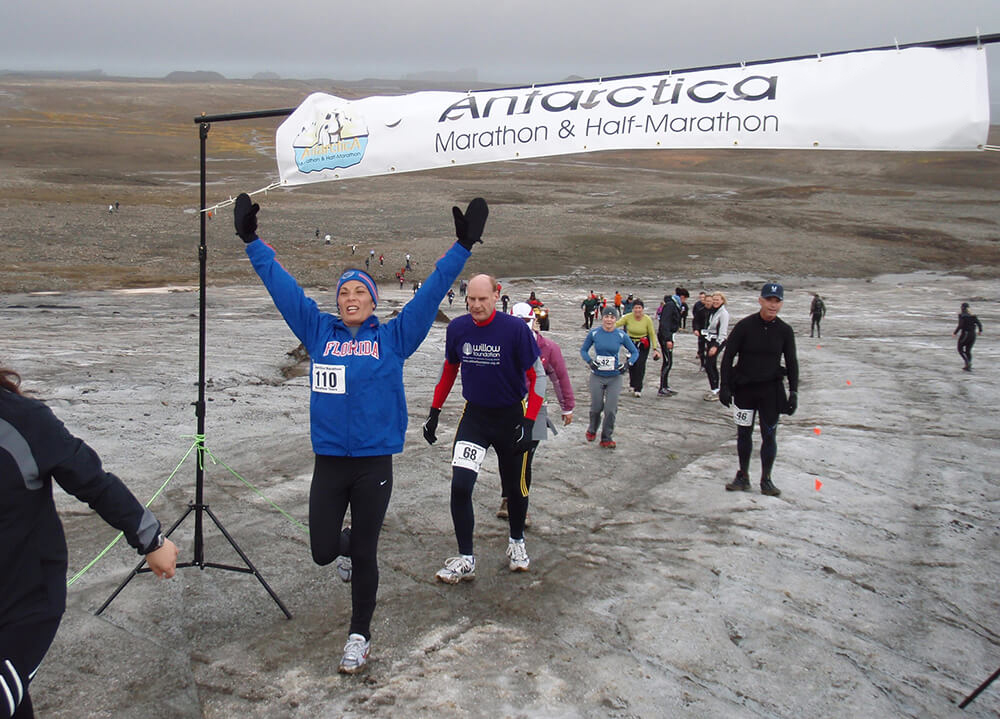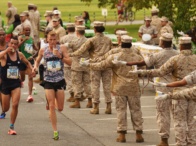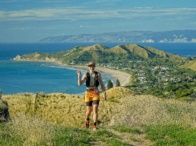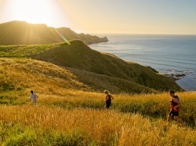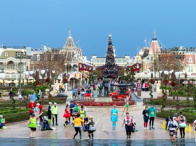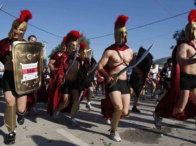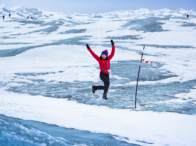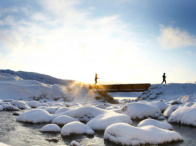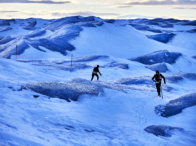Are you looking for advice about training for the Antarctica Marathon or Half Marathon?
While your training regime for these two events will remain similar to how you prepare for a regular road-based race, there are some tips that can help you better prepare for the conditions.
As participants in this race ourselves, we have first-hand experience competing in this incredible race and have provided key training tips, recommended gear, and what temperature to expect.
Antarctica Marathon Overview
The Antarctica Marathon route is 42.2km (21.1km for the half) and is set on dirt roads, which can become muddy depending on the weather.
While the general course is similar year to year, it varies annually based on base operations, road conditions, and weather.
Temperatures typically range from -9.5°C to 1°C, not accounting for wind chill, which can drop temperatures by an additional 12°C.
While heavy snow is uncommon, light snow flurries frequently occur, adding another layer of challenge to the race.
These factors will affect how you train for this race, which we will cover below.
Training for the Antarctica Marathon
Cold Weather Adaption
This tip might be difficult for some participants depending on where in the world you live, however, we recommend doing your best to simulate cold conditions if possible.
If you can travel to a nearby location that you know will have a temperature similar to the race, you’ll be able to ensure you’re prepared for racing in colder conditions.
This will give you a great opportunity to practice how you’re going to layer during the race as you’ll get a better understanding of how your body responds and fine-tune your clothing strategy for race day.
Finally, if you can practice in a colder climate that is windy, this will prepare you for the potential windy conditions you’ll experience on race day.
Terrain Familiarisation
While altitude shouldn’t play a factor in the race with the highest point being approximately 69 metres (226 feet) above sea level, there are several inclines and declines you’ll need to be prepared for.
We recommend that you incorporate trail runs into your routine to get used to uneven surfaces similar to the Antarctica terrain.
When possible, look to seek out muddy trails as this will help you get used to the potentially slippery and challenging conditions of the dirt roads in Antarctica.
Learn more about the Antarctica Marathon elevation gain and loss to help get a better idea of the course.
Gear Testing
The last thing you want is to realise halfway through the race that your chosen gear is affecting your performance or even preventing you from finishing.
We’ll cover the recommended gear shortly but ensure you are happy with your trail running shoes and that they provide great grip and comfort.
We also advise you to train with a hydration pack and other re-fueling gear you’ll need to carry due to the lack of supply stations throughout the race.
Distance Training
The challenging terrain will slow your pace so we recommend you incorporate longer, slower runs into your training schedule to adapt.
Focus on time spent running rather than distance covered, gradually increasing your long runs to build the endurance required for extended periods on your feet.
Energy Management
Cold weather affects how your body processes food.
If you have access to train in similar weather conditions, practice your race-day nutrition plan during training runs in cold conditions to ensure your body can handle the energy gels and snacks.
This type of weather can also mask dehydration.
Make a conscious effort to drink regularly, even if you don’t feel thirsty.
Like we mentioned before, you’ll need to consider the weight and accessibility of your nutrition and hydration supplies, as you will need to carry everything with you.
By refining your energy management plan, you can maintain optimal performance and endurance throughout the marathon.
Our Recommended Antarctica Marathon Gear
There are a couple of key pieces of information that you’ll need to be aware of before you begin
Each runner is responsible for their own liquids, so make sure to bring 2 or 3 water bottles for race day.
Also, pack any electrolyte replacement fluids, sports gels, or energy supplements you commonly use, as only water will be available in Antarctica.
To prevent littering and ensure all items are secure, all energy supplements must be removed from their paper packaging and placed in plastic flasks or other containers that won’t blow away.
Here are our other key recommendations to ensure you are well-equipped for the race:
Clothing
- Layering System: Use a three-layer system to manage temperature and moisture. Start with a moisture-wicking base layer, followed by an insulating mid-layer, and finish with a windproof and waterproof outer layer.
- Thermal Wear: Invest in high-quality thermal clothing, including thermal tights and tops, to keep warm in freezing temperatures.
- Extremity Protection: Wear insulated gloves, a thermal hat, and a neck gaiter to protect against frostbite and wind chill.
Footwear
- Trail Running Shoes: Choose trail running shoes with excellent grip to handle icy and muddy surfaces. Ensure they are waterproof and provide good insulation.
- Socks: Opt for thermal, moisture-wicking socks. Consider double-layer socks to prevent blisters and keep your feet warm.
Accessories
- Hydration Packs: Use a hydration pack with insulated tubes to prevent water from freezing. Ensure it is comfortable and has enough capacity for your hydration and nutrition needs.
- Sun Protection: Despite the cold, UV rays can be intense. Wear sunglasses and apply sunscreen to exposed skin.
Hydration and Nutrition
- Insulated Bottles: Use insulated water bottles or hydration bladders to keep fluids from freezing. Keep in mind
- Energy Gels and Snacks: Bring easy-to-consume energy gels and snacks that you have tested during training. Ensure they remain accessible and are easy to open with gloved hands.
Miscellaneous
- GPS Watch: Use a GPS watch to monitor your pace and distance. Ensure it has a long battery life suitable for the cold.
- Headlamp: Consider carrying a headlamp in case of low visibility due to weather conditions.
Testing your gear during training runs is crucial to ensure comfort and functionality.
Proper gear selection will help you stay warm, hydrated, and energised, enabling you to focus on the race and enjoy the unique experience of running in Antarctica.
Looking to take part in this extraordinary event?
If you’re looking to compete in the Antarctica Marathon, you’ll need to book through a registered with an approved travel partner such as Travelling Fit.
Our Antarctica Marathon travel packages not only get you to and from the race but are packed with once-in-a-lifetime adventures and excursions that will create memories that you’ll cherish for the rest of your life.
These include:
- Scenic journeys through the Beagle Channel, Drake Passage, Shetland Islands, and Antarctic Peninsula.
- Guided wildlife excursions and onboard lectures by historians and scientists.
- A half-day guided city tour in Buenos Aires
- Kayaking with whales
- + More
If you’re considering entering this extraordinary event, check out our previous year’s Antarctica Marathon or Half Marathon package pages to learn more and to give you an idea of pricing for the 2025 event. Please use pricing and information on our website as a guide only.
Otherwise, you can always contact us directly if you’d like to speak with a member of our friendly and helpful staff!
Don’t miss out on this unique adventure—register with Travelling Fit today!

